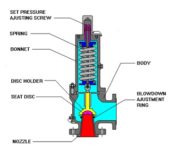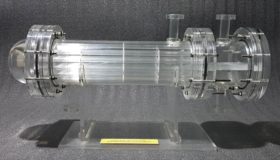Combined Bending & Torsion Apparatus Model MT 114
Home » Products » Combined Bending & Torsion Apparatus Model MT 114
Combined Bending & Torsion Apparatus Model MT 114
The object of Sci-tech Bending & Torsion Apparatus Model MT 114 is to determine what levels of combined bending and torsion cause elastic failure in different materials, and to compare them with various theories of failure. The apparatus uses specially machined ‘necked’ specimens which are clamped at one end to the base plate and at the other end to a counterbalanced circular loading plate. Regular interval graduations on the loading plate allow a special hanger to locate. The special hanger enables pure bending, pure torque or a combination of both to be applied depending on the position of the hanger. The specimen deflection is measured by a dial gauge mounted diametrically opposite the load point. A set of calibrated weights is supplied along with a set of test specimens. Further test specimens are available separately.
| Size: | 60cm x 50cm x 70cm (LxWxH) |
| Weight: | 20 kg |
Item Description
Features
- Long lasting, High Quality, compact bench unit
- Effective demonstration capability apparatus
- Designed to offer Combined bending and Torsion experiments in one unit
- Specimen materials supplied of three types, five of each type
- Length of test material supplied for own specimen creation
Much of the design of parts in mechanical and civil engineering is complicated by there being biaxial or triaxial stresses for which some failure state has to be determined. Obvious examples are high pressure cylinders containing liquids or gases and concrete hinges for large bridge bearings. For more than a century, physicists, mathematicians and engineers have been proposing various theories of failure. Some theories have been attempts to explain observed failures while a few have tried to base a mechanism on fundamental properties of materials.
It is evident that there is a considerable difference between the behavior of ductile and brittle materials. That apart, it is quite difficult to determine failure with sufficient accuracy in experiments designed to show which failure theory is most applicable. Hence, it is frequently found that codes of practice lay down what appears to be a somewhat empirical design method which experience has proved to be workable.
This simple machine uses inexpensive test specimens made from round bar. The specimen is clamped at one end to the base bracket and at the other to a counterbalanced circular loading plate. This plate is graduated in 15° intervals. A special hanger enables pure bending, pure torque or combined loads to be applied depending on the position of the plate. The specimen deflection is measured by a dial gauge mounted diametrically opposite the load point. In the event of a specimen failure safety is ensured by set screws
This equipment is part of a range designed to both demonstrate and experimentally confirm basic engineering principles. Great care has been given to each item so as to provide wide experimental scope without unduly complicating or compromising the design. Each piece of apparatus is self-contained and compact. Setting up time is minimal, and all measurements are made with the simplest possible instrumentation, so that the student involvement is purely with the engineering principles being taught.
The object of Sci-tech Bending & Torsion Apparatus Model MT 114 is to determine what levels of combined bending and torsion cause elastic failure in different materials, and to compare them with various theories of failure. The apparatus uses specially machined ‘necked’ specimens which are clamped at one end to the base plate and at the other end to a counterbalanced circular loading plate. Regular interval graduations on the loading plate allow a special hanger to locate. The special hanger enables pure bending, pure torque or a combination of both to be applied depending on the position of the hanger. The specimen deflection is measured by a dial gauge mounted diametrically opposite the load point. A set of calibrated weights is supplied along with a set of test specimens. Further test specimens are available separately.




